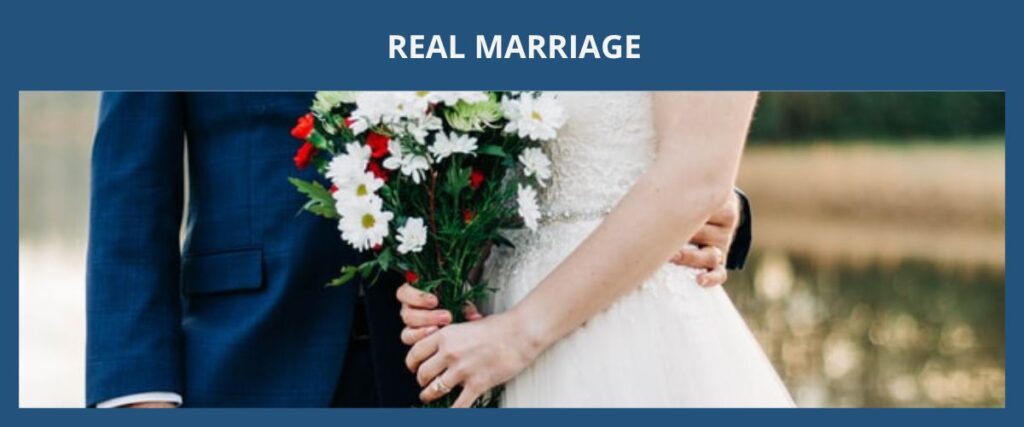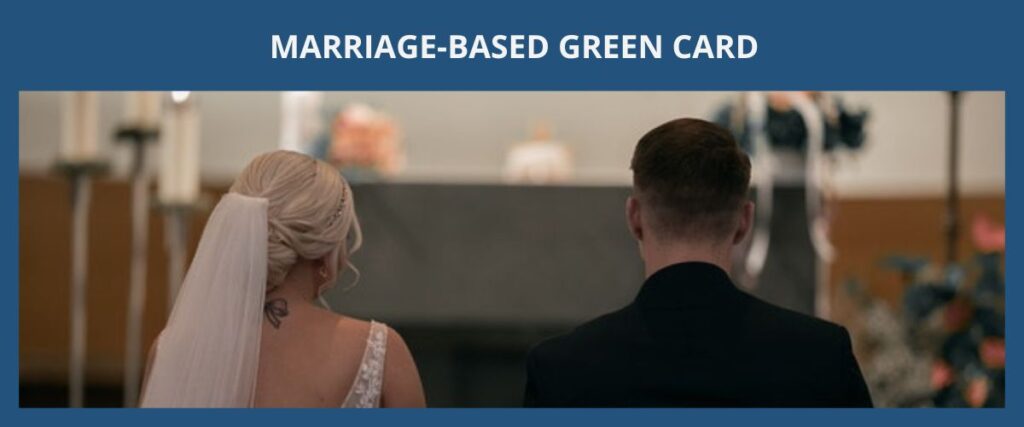The K1 fiancé(e) visa is a nonimmigrant (temporary) visa for U.S. citizens to sponsor their foreign fiancé(e) to enter the United States if they plan to get married within 90 days. After the couple gets married, the foreign fiancé(e) can apply for an adjustment of status to become a green card holder (lawful permanent resident).
Table of Contents
A qualified person for a K1 visa must (1) be the fiancé(e) of a U.S. citizen, (2) the couple must intend on getting married within 90 days from the date of the foreign fiancé(e) entering the United States, and (3) the couple must also have met each other at least once in person within 2 years prior to filing the K1 visa petition unless a waiver is approved. All prior marriages of both persons must be legally terminated by divorce, annulment, or death.
Waiver for Meeting in Person Requirement
A waiver can be requested if meeting in person would violate strict long-established customs of the fiancé(e)’s foreign culture or cause extreme hardship for the U.S. citizen. Traditional arrangements and customs can be shown by affidavits from religious or other appropriate authorities.
Extreme hardships may be shown by evidence that there were financial, medical, political reasons for the couple not to be able to meet in-person within the 2-year period prior to filing the K1 visa petition. For example, the couple met 3 years ago and maintained a long-distance relationship but did not see each other in person in the past 2 years because they did not have the financial means to travel internationally during that period of time.
The original statutory wording for the K1 visa qualifications can be found in INA §214(d)(1).
If the couple does not get married within 90 days of the date that the foreign fiancé(e) enters the United States, the K1 visa will expire and the foreign fiancé(e) will be out of status and in risk of deportation which will have a negative impact at the time when the person applies for citizenship later down the road. There are no extensions for K1 visas and second K1 visas are not as easy to obtain.
If the marriage happens after 90 days, the foreign fiancé(e) will no longer be able to immediately file for an adjustment of status to become a green card holder (lawful permanent resident) and the U.S. citizen would have to file a marriage-based green card petition (Form I-130). This will result in additional fees and delays for the foreign fiancé(e) to obtain their green card because the marriage-based green card petition (Form I-130) must be approved before the foreign fiancé(e) can adjust their status into a green card holder.
K1 Visa Holder Cannot Change Into Different Nonimmigrant Visa Status
The K1 visa does not allow the foreign fiancé(e) to change into any other temporary nonimmigrant visa such as an F-1 student visa or an H-1B work visa. The K1 visa also does not allow the foreign fiancé(e) to adjust their status into a green card holder based on a marriage other than the original U.S. citizen that sponsored that K1 visa.

The K1 visa has five main requirements that need to be satisfied: evidence must be provided to the USCIS to show that the (1) the person must be the fiancé(e) of a U.S. citizen, (2) the couple must intend on getting married within 90 days from the date of the foreign fiancé(e) entering the United States, (3) both persons are legally free to marry, (4) the foreign fiancé(e) will not become a public charge (typically the U.S. citizen must have income that is at least 100 % of the federal poverty guideline), and (5) the couple must have met each other for at least once in person within 2 years prior to filing the K1 visa petition unless a waiver is approved.
Evidence Required for the K1 Visa
A general (not exhaustive) checklist for what is required for a K1 visa of a U.S. citizen’s foreign fiancé(e) is listed below. The evidence provided to the USCIS for the K1 fiancé(e) visa petition must show:
The person sponsoring the K1 visa petition is a U.S. citizen
- Two passport photos of the U.S. citizen
- U.S. passport (valid)
- Birth certificate
- Naturalization Certificate or Certificate of Citizenship (issued by the USCIS)
- Consular Report of Birth Abroad (Form FS-240) issued by a U.S. consulate or embassy
- U.S. consular officer’s verification of U.S. citizenship with valid U.S. passport
- Documents that show legal name change (e.g., court judgment of name change, marriage certificate, divorce decree, adoption decree)
The foreign fiancé(e) is admissible to enter the United States
- Passport (expiration date must be more than 6 months than the time intended to stay in the United States)
- Two passport photos
- Police certificates (it should include the country of residence and all countries that the person has lived for at least 6 months since 16 years old)
- Sealed medical examination form
Foreign fiancé(e) and U.S. citizen are both legally single and free to marry
- Birth certificates (it should show names of both parents)
- Divorce by legal termination of all prior marriages for the foreign fiancé(e) and U.S. citizen (e.g., divorce decree, annulment order, death certificate of prior spouse)
The relationship is bona fide (real) and the couple plans to get married with 90 days of the foreign fiancé(e) arriving in the United States
- Evidence of the couple meeting in person at least once within the immediate past 2 years (e.g. letters, dated photos, phone records, cards, emails, itineraries, boarding passes…etc.)
- Affidavits from a third party (friends and family members) who has personal knowledge (first-hand) that the relationship is real (it should include the writer’s full name, address, place of birth, date of making the affidavit, and the detailed explanation of how and what the person knows about the relationship)
- Wedding invitations, receipts of costs made for the wedding, deposits on venues, etc.
- Signed statements from the couple confirming the intention of getting married within 90 days of the foreign fiancé(e) entering the United States
The foreign person will not become a public charge in the United States
- Affidavit of Support (Form I-134)
- Documents that show the U.S. citizen’s income is at least 100 % of the federal poverty guideline (e.g., most recent tax returns, bank statements)
The total time a K1 visa takes is consisted of the processing time for (1) the K1 visa petition (Form I-129F) with the USCIS and the (2) visa application interview (DS-160) at a U.S. consulate or embassy overseas.
A rough estimate for the Form I-129F petition is around 6 to 9 months and the completion of the interview stage should require around 2 to 3 months. Factors that influence the K1 visa petition processing time usually include but are not limited to if there was any Request for Evidence (“RFE”) issued, and the caseload of the USCIS service center, National Visa Center (NVC), and the U.S. consulate or embassy.
K1 Visa General Process
There are five main steps for the fiancé(e) of a U.S. citizen to obtain a K1 visa to enter the United States and then adjust into a green card holder:
Step One: Filing the K1 Visa Petition
The U.S. citizen files a K1 fiancé(e) visa petition (Form I-129F) to the USCIS.
Step Two: Interview at U.S. Consulate or Embassy
After approval of the K1 fiancé(e) visa petition, the National Visa Center (NVC) will transfer the case to the U.S. consulate or embassy. The fiancé(e) will be notified for a scheduled interview at the U.S. consulate or embassy overseas and the documents that they are required to bring. After the fiancé(e) is approved at the U.S. consulate or embassy interview, they will be granted a K1 visa which is valid for up to 6 months and can be used for a single entry into the United States.
Step Three: Changing into K1 Visa Status
When the K1 fiancé(e) travels to the United States, the CBP officer at the port of entry must admit the fiancé(e) to enter the United States for their K1 visa status to become activated.

Additional steps for the foreign spouse to obtain their marriage-based green card
Step Four: Get Married Within 90 days & Filing Adjustment of Status
The couple must get married to each other within 90 days of the foreign fiancé(e) entering the United States and the foreign fiancé(e) has to file an adjustment of status (Form I-485) to become a green card holder. The K1 foreign spouse will be given a 2-year conditional green card because the couple would have been married for less than 2 years from the date that the adjustment of status was approved.
Step Five: File Removal of Conditions Petition
Within 90 days of the 2-year conditional green card expiration date, a removal of conditions (Form I-751) must be filed for the conditional green card to change into a regular green card.
After entering the United States, the K1 foreign fiancé(e) and their K2 dependent children can immediately file for work authorization (EAD, Form I-765) which will be valid for 90 days from the foreign fiancé(e)’s entry date. Alternatively, the foreign fiancé(e) can file for work authorization (EAD, Form I-765) concurrently (at the same time) with the adjustment of status (Form I-485) which will be valid for 1 year and can be renewed in one-year increments.

Dependent children (unmarried and under 21 years old) of the K1 foreign fiancé(e) can apply for a K2 visa to enter the United States. The child can enter with the K1 foreign fiancé (e) or join the K1 foreign fiancé (e) within 1 year of the issued K2 visa, and can file for an adjustment of status to change into a green card holder immediately after the couple gets married. If the child does not enter the United States after 1 year, a separate family-based green card petition will be required for the child.
Typically, K2 children over 14 years old will be required to attend the in-person interview along with the K1 fiancé (e) at the U.S. consulate or embassy. The K2 child may be asked questions about the relationship of the K1 fiancé (e) and U.S. citizen.
The K1 visa is a temporary visa for the foreign fiancé(e) of a U.S. citizen to enter the United States to get married and wait for their marriage-based green card. Dependent children of the K1 foreign fiancé(e) can also join them with a K2 visa. In most cases, the K1 foreign fiancé(e) visa is faster and more convenient than a marriage-based green card petition because it allows the foreign spouse (previously the fiancé(e)) of a U.S. citizen to file for an adjustment of status to become a green card holder immediately after the couple gets married.
If you have a marriage-based visa (fiancé(e) of U.S. citizens) immigration question, please fill out our contact us form or send us an email with some basic information about your background and your immigration needs. We will do our best to respond within 48 hours.
How we can help?
Kylie Huang Law’s immigration attorney will help identify what type of marriage-based visa the client is qualified for and whether there are other visa options available to the client. We will work closely with our clients to prepare their marriage-based visa petition and we will also strategize on how the marriage-based visa petition should be presented in the filings and in the interview to achieve the best chances of approval. It is advised and common practice to retain an immigration attorney for certain unusual marriage-based visa petitions due to the complexities in the immigration process and visa requirements.
What does the typical process look like to retain (hire) us?
- Step 1:
- Step 2:
- Step 3:
- Step 4:
- Step 5:
- a.
- b.
- c.
- Step 6:
- Step 7:
- Step 8:
- Fill out the form (with some basic information on what your immigration needs are)
- Sign up and log into the client portal to schedule an appointment online
- Attend scheduled appointment (typically a phone call or zoom meeting)
- Retainment (signing a contract to hire us)
- Start processing case
- Gathering required documents
- Preparing paperwork
- Confirming contents of documents that will be submitted
- Filing the case
- Following up on the status of the case
- Close the case when a final determination is issued
- Step 1:
- Step 2:
- Step 3:
- Step 4:
- Step 5:
- a.
- b.
- c.
- Step 6:
- Step 7:
- Step 8:
- Fill out the form (on what your immigration needs are)
- Sign up and log into the client portal to schedule an appointment
- Attend scheduled appointment (typically a phone call or zoom)
- Retainment (signing a contract to hire us)
- Start processing case
- Gathering required documents
- Preparing paperwork
- Confirming contents of documents that will be submitted
- Filing the case
- Following up on the status of the case
- Close the case when a final determination is issued
- Step 1:
- Step 2:
- Step 3:
- Step 4:
- Step 5:
- a.
- b.
- c.
- Step 6:
- Step 7:
- Step 8:
- Fill out the form (on what your immigration needs are)
- Sign up and log into the client portal to schedule appointment
- Attend scheduled appointment (typically a phone call or zoom)
- Retainment (hire us)
- Start processing case
- Gathering required documents
- Preparing paperwork
- Confirming content of documents that will be submitted
- Filing the case
- Following up on the case status
- Close the case when a final determination is issued
RELATED ARTICLES
- K1 Visa Checklist (Fiancé & Fiancée)
- K Visa Overview
- K3 Visa (Foreign Spouse)
- K3 Visa Checklist (Foreign Spouse)
- Marriage Based Green Card (IR1 / CR1 / F2A)
- Spouse of Deceased U.S. Citizen (EB4)
- Immediate Relative of U.S. Citizen (IR)
- Married Children (F3) & Unmarried Children Over Age 21of U.S. Citizen (F1)
- Parents of U.S. Citizen (IR5)
- Spouse of U.S. Citizen Green Card Checklist (IR1 / CR1)
- Widow(er) of U.S. Citizen Green Card Checklist (EB4)
- Children of U.S. Citizen Green Card Checklist (IR2 / F1 / F3)
- Sibling of U.S. Citizen Green Card Checklist (F-4)
- Parents of U.S. Citizen Green Card Checklist (IR5)
- Family Members of Green Card Holders (F2A / F2B)
- Brother and Sister of U.S. Citizen (F4)
- Spouse of Green Card Holders Checklist (F2A)
- Children of Green Card Holders Checklist (F2A / F2B)

